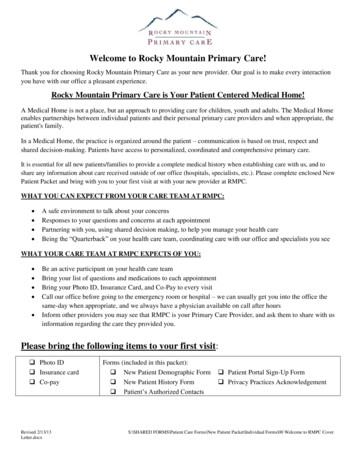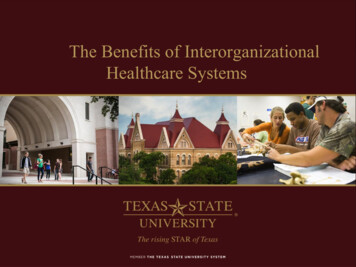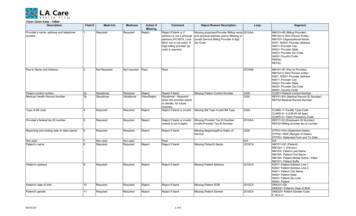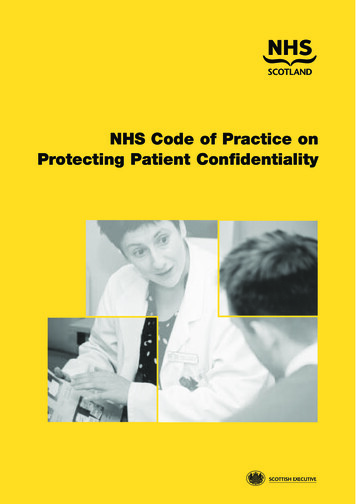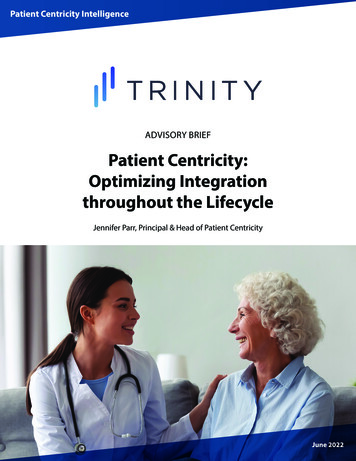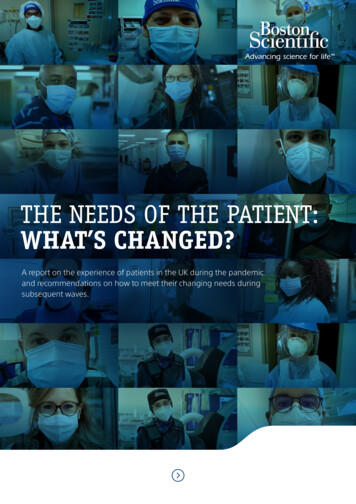
Transcription
THE NEEDS OF THE PATIENT:WHAT’S CHANGED?A report on the experience of patients in the UK during the pandemicand recommendations on how to meet their changing needs duringsubsequent waves.
THE NEEDS OF THE PATIENT:WHAT’S CHANGED?As hospitals see admissions for COVID-19 rise during asecond and subsequent waves, huge challenges willagain face patients who need the National Health Service(NHS). To assess ‘The Needs of the Patient: What’s Changed?’, Boston Scientific assembled a roundtable of highlyregarded patient group leaders during MedTech Week(12-16 October) to discuss such topics as: the impact onpatients with long-term chronic conditions, the potentialimpact on patients of a significant second wave of thepandemic, and what can we do to better support patients in this ‘new normal’ world of uncertainty?healthcare system, particularly those involved in designing processes around the patient’s experience.Special thanks to our moderator, Ian Chamberlain, director, Life Science Access Academy, and our panelists:Rachel Power, chief executive of The Patients Association;Malcolm Packer, head of charity affairs and communications of Kidney Cancer UK; Vanessa Hebditch, directorof communications and policy of British Liver Trust; andTrudie C A Lobban, MBE, founder and CEO of ArrythmiaAlliance AF Association and STARS (Syncope Trust).Our goal was not only to share and better understandthe experiences of patients from the first wave of thepandemic, but also to provide practical guidance for subsequent waves.Michelle SullivanHealth Economics and Market Access Lead UKBoston ScientificThis report summarises the key points of this discussionand is useful reading for anyone involved today in the UK2
PART I:needs. This has delayed access to care by decreasingreferrals and increasing cancelled appointments.THE PANDEMIC CREATEDCHALLENGES FOR ALL PATIENTSThe impact of cancelled procedures, delayed diagnostics and reduced referrals on patient care have yet tobe fully evaluated but concerning statistics on patientoutcomes have started to emerge. This has been compounded in part by poor communication with patientscausing increased anxiety.Our health and care systems have been tested as neverbefore by the COVID-19 pandemic, a viral outbreak ofunprecedented scale. To fight the coronavirus and keepit from spreading, large parts of our lives have beensignificantly disrupted whilst researchers strive to findtreatments, vaccines and cures and healthcare systemsstruggle to provide safe and effective care for COVID-19patients. Yet through all of this, patients continue toneed timely medical care.REDUCED CAPACITYThe pandemic forced local health systems to quickly re-organise and re-distribute their services and staff to handlethe huge rise in patients requiring critical and specialistcare, putting even more strains on capacity.1 This was further complicated by the urgent need to hire and train newpeople as well as find cover for those health workers whoneeded to isolate due to COVID-19 symptoms and positivetests. At the time of writing its estimated that 30,000 NHSworkers were off or self-isolating due to COVID-19.2Despite the exemplary efforts of our health care workers, there have been considerable challenges and understandably non-COVID patients have not always beenable to receive the care they need.The Patients Association conducted a wide-ranging surveyof patients during the pandemic which found that whilethere were some examples of really good practices, overall“it painted a pretty stark picture of how people were feeling,” said Rachel Power, chief executive of the association.In addition, COVID-19 has led to increased measuresaround infection prevention and social distancing, whichfurther impact capacity.As a second wave takes hold, concern is increasing forthe mental health of front-line workers who have beendealing with the unrelenting pressure of the pandemic.Nearly 60% of the 1,200 care workers questioned metthe criteria for at least one of three things – anxiety,depression and post-traumatic stress disorder, according to a study by the Covid Trauma Response WorkingGroup.3 4One result has been an outpouring of calls from patients to patient organisations asking for help andadditional support. At the British Liver Trust, there hasbeen a 155% increase in calls compared to a year ago,most of them related to COVID-19, said Vanessa Hebditch, director of communications and policy. ArrythmiaAlliance had a three-fold increase in calls from worriedpatients during the pandemic, said Trudie Lobban, MBE,Arrythmia Alliance founder and CEO.As far back as June 2020, it was estimated that the NHSmay not reach its pre-COVID-19 capacity until late in2021.5 It’s clear capacity and staffing issues continue toaffect any sustainable service recovery and the systems’ability to provide patient care.Clearly, the pandemic has placed further strain on healthsystems already having trouble keeping up with patient3
FEWER REFERRALS, CANCELLED APPOINTMENTSA key reason that patients were hesitant to get healthservices was their confusion or fear due to poor or inadequate information about health risks, as we shall seein the next section.Patient hesitation in seeking care, diverted resourcesand lower capacity have reduced patient referrals andresulted in many cancelled appointments.POOR OR INADEQUATE INFORMATIONKEPT PATIENTS AWAYBy mid-April there was a 90% decrease in routinereferrals, while urgent referrals and two-week referralsfor suspected cancer fell by 78% and 67%, respectively.6 About 42% of patients had their care cancelled ordelayed during March and July, according to an IpsosMori poll of more than 2,000 patients.7 This trend hascontinued further into 2020 with a recent report by theHealth Foundation highlighting the number of new carepathways has dropped by up 37% in some regions.8The unprecedented and ever-changing nature of thepandemic made it difficult to establish a clear set ofnational guidelines in early stages of the pandemic. As aresult, despite the best efforts of national organisationsand local providers to inform and educate patients andcare providers, a disconnect at times with the patientcommunity has impacted – and continues to impact –access to care.This was also confirmed by a recent survey from The Patients Association which found that 67% of respondentshad had health and care appointments cancelled.9In the initial stages of COVID-19, many patients cancelled appointments due to fear, anxiety or uncertaintyabout whether it was safe to see a doctor or go to thehospital. The Patients Association survey found thatpatients were confused due to conflicting or inadequateinformation, and that 47% had chosen to put off accessing services and support.11 Likewise, an Ipsos Mori pollfound that 23% of patients with cancelled appointmentschose to cancel their appointment.12All elements of care were affected, even life-savingtherapies used to treat cardiovascular disease.Early in the pandemic, heart rhythm patients told the Arrythmia Alliance that most operations were cancelled, suchas pacemakers or ablation for atrial fibrillation, and “onlyemergency ICDs were being implanted,” Lobban said.Many patients were too confused or afraid to see theircare providers. Overall, 48% of patients were extremelyor very worried about catching COVID-19, half of whomsaid they lacked trusted information, according to aPatient Information Forum survey completed in late July2020.13 Three in four (75%) said information on COVID-19was conflicting to some degree, while more than half(57%) worry about attending future face-to-face care.14In assessing the impact of the pandemic on clinicalpathways for routine cardiovascular care, the National Institute for Cardiovascular Outcomes Research (NICOR) dida series of analyses using national datasets that found:10 A 35% fall in myocardial infarctions. A 66% drop in patients presenting to hospital withheart failure.The British Liver Trust participated in a COVID patientsurvey that found that more than one in four liver patients (26%) felt they did not have enough informationto make decisions about their health. A reduction in interventional CVD procedures,especially electives, such as a 50% decline for TAVIand up to a 92% plunge in ablation procedures.4
The patient experience in UK, seems to match patientexperiences elsewhere, as the enormous scale andchangeable nature of the pandemic posed challengesearly on that lead to communication issues. For example, many U.S. patients were nervous and uncertain,according to a Boston Scientific survey15:“Patients started out with a big fear of COVID-19, butthat flipped over as they became used to the ‘new normal’ – now they seem to worry more again about theircancer, which in a way is a good thing,” said MalcolmPacker, head of charity affairs and communications forthe Kidney Cancer UK. 66% are nervous or very nervous about meetingwith their healthcare professional.Even so, all the panelists agreed that issues aroundcommunications stubbornly persist and need to beaddressed in the second wave. 76% were nervous about going to the hospital orsurgery center.PATIENT WAIT LISTS 70% were uncertain about next steps toreschedule their procedure.Although the patient hesitancy described above mayhave initially tempered the expected exponential rise inwaiting lists that were being predicted early summer, recent evidence indicates that waiting times have increased. As a result, many who want care are receiving it inless timely way.16Multiple data points all point to inconsistent communication having contributed to the fear, anxiety, confusionand uncertainty among patients to varying degrees overthe duration of the pandemic.We have already seen the large decline in referrals – notjust routine referrals, but referrals for suspected cancer.17A recent report by the Health Foundation shows that thenumber of new care pathways has dropped by 37% insome regions.18 Patient experiences captured in surveysby Ipsos Mori and The Patients Association observedsimilar findings. 19 20Panelists illustrated the patient stories behind the statistics: A patient received a government letter saying theywere in the shielding group, then received anotherletter later saying that they were not in that group. Many patients said that they did not receive information from the government until weeks after thelockdown. “Cancer surveillance almost stopped,” Hebditchsaid. “One patient told us they went in for diagnosis, but never got the results – the liver cancerteam was not in touch.”Early fears of accessing treatments have abated. Forexample, Kidney Cancer UK did three surveys of itsmember patients during the pandemic – one soon afterlockdown, a second two weeks later, and a third at theend of August.5
42%X 2% of patients had their care4cancelled or delayed duringMarch and July.2167% There was a 67% decreasein two-week referrals forsuspected cancer.2235% 35% fall in myocardialAinfarctions.66% 66% drop in patientsApresenting to hospital withheart failure.population, have gotten worse. The isolation and diminished access to care caused by the pandemic affectsthe mental well-being of many. Chronic pain patientsawaiting spinal cord stimulation procedures feel theirphysical and mental well-being is being jeopardised bydelays due to the COVID-19 pandemic, according to arecent survey.25Disabled and chronically ill people also have fallen behind; for example, those with conditions that did notmeet the criteria of the government’s “clinically mostvulnerable” list (those on the list are eligible for specialservices) have been left with little access to care or thesupport they need as part of daily life.26 Interventional CVD procedures,especially electives, were down50% for TAVI and 92% forABLATIONablation procedures.TAVI &“A number of disabled, chronically ill,older people felt forgotten and left behind,”Power said. “There was a lack of communicationabout what was happening withtheir treatment.”Some areas are being hit harder than others. “One hospital in the Midlands said it would take three years to catchup with all of their heart failure patients,” Lobban said.DAMAGE TO PATIENT HEALTHAbout 50% to 60% of those surveyed by Kidney CancerUK said they were not in the vulnerable group whenthey thought they should be. “They felt completely pushed aside, hung out to dry, almost” Malcolm Packer said.The pandemic has put at risk or harmed the physicaland mental health of many patients. More than half ofpatients, for example, felt their health and care needshad not been supported overall during the pandemic,according to The Patients Association.23 Nearly six out ofThe pandemic has increased inequities among patients,with people from ethnic minorities and vulnerablepopulations most at risk of infection and death from COVID-19.27 28 29 Although poverty and social disparities arekey factors in this inequity, another key reason is poorcommunication with and lack of trust among minorities,a Race Disparity Unit study concluded.3010 (59%) patients are worried that their condition wouldget worse due to the pandemic, according to the Association’s survey.24COVID-19 has put some populations – often vulnerable groups already facing inequities in care – at higherrisk. Patients with mental health issues, chronic pain orchronic illnesses feel left behind, and health care disparities, already an issue with the poor and ethnic minorityDespite the best efforts of health care providers, COVID-19 has inevitably led to a rise in deaths even in6
addition to those who died of the virus. There were anestimated 2,085 excess deaths in England and Walesdue to heart disease and stroke during the peak of thefirst wave of COVID-19, according to a study.31 Anotherstudy projects that there could be as many as 35,000excess deaths due to missed or delayed cancer diagnosis during the pandemic.32or inadequate communications have been obstacles totimely, effective care. Our panelists have several specificsuggestions for how communications can be improved.Our panelists also reference a variety of bright spots forpatients that have appeared during the pandemic – brightspots that should be encouraged and reinforced goingforward. Remote care and the rapid adoption of technology has helped patients to get the care they need withoutexposing them to the risk of infection; this has made thedelivery of care safer and also more efficient. Meanwhile,new patient data gathering efforts and approaches toimproving the NHS show promise in making the deliveryof care more accessible, effective and efficient.As the rate of infections declined over the summer, access to healthcare seemed to improve across the boardand frontline workers.But while cancelled and deferred appointments mayhave suppressed demand in the short term, it couldcreate an even larger problem in the long run. Someexperts worry about a “growing iceberg of harm createdby delayed outpatient follow-up appointments.”33 In fact,nearly six out of 10 (59%) patients worry their conditionwill get worse due to the pandemic, according to thePatients Association’s survey.34 As the UK experiences aIMPROVING COMMUNICATIONSPoor or inadequate patient communications proved tobe a drawback to patients getting the care they neededduring the pandemic. Poor communication was a keyreason for increased health disparities during the pandemic.35 So, how can we improve the approach for thesecond wave?second wave, a number of Trusts are finding it necessaryto cancel or drastically restrict elective surgery once more.What have we learned that can be practically implemented this time?Better communication should involve maintaining theprinciples and values of patient choice, shared decisionmaking and voice, so that alongside clinicians, servicesare also shaped by patients, disabled people and otherswho most need them, Power said.36PART II:WHAT HAVE WE LEARNED FROMTHE PANDEMIC AND HOW WE CANHELP PATIENTSOverall, the Patients Association recommends that patients be provided clear, concise and timely communication, updated regularly, about the impact of the crisison support and services, what is available in the interim,and when and how services may begin to restart.37Through a combination of making improvements andtapping existing strengths, our panelists believe that wecan improve patient access and health by creating morecapacity, improving care and better informing patients.This means better information, too. Consider how to liaise with the 57% of patients who are worried about thesafety of future appointments, Hebditch said.They underscore the importance of efforts to improvecommunications with patients. As we have seen, poor7
“Good communication comes from having patientpartnership as the cornerstone,” Power said. “We needto build that better.”“It’s not enough just to say thatit’s safe to go back to hospitals,”Hebditch continued. “We have toexplain to them how hospitals arebeing kept safe.”One trend that has improved communication andaccess to care for patients has been rapid adoption ofremote care, as we will see in the next section.Recommendations to improve communications include:REMOTE CARE AND THE RAPID ADOPTIONOF TECHNOLOGY Be consistent. “We found that patients facing thesame circumstances were being told differentthings,” Malcolm said. “The message needs to besteady.”One of the positive aspects of the pandemic has beenthe accelerated adoption of technology. To free up theirtime, reduce congestion in health care facilities and limitexposure to infection, many GPs and specialists turnedto video consultations during the pandemic.39 Obstetricians provided routine visits for normal pregnanciesover the phone; dermatologists diagnosed simple skinproblems over video; and psychotherapists providedface-to-face consultation online. This trend has been aided by the growing popularity of home diagnostic tools,such as blood pressure monitors, pulse oximeters thatmeasure blood oxygen levels, heartrate and exercisemonitors, and other devices. Dispel myths and fears. Explain how hospitals arekept safe. By building trust in NHS services among atrisk groups, such as ethnic minority people, the NHScan be more effective in correcting misinformation.38 Make mental health information more visible. Whenit comes to funding information, mental health resources need to be given the same importance asinformation on other health services. “To ensure thatno one is left isolated and alone,” Power said.In addition, remote monitoring technology has made iteasier for doctors and patients to check on the patient’shealth without an in-person visit. Translations. To expand access, materials shouldbe published in different formats and languages.These approaches – virtual visits and remote monitoring – should be refined and accelerated into the future,according to our panelists. People without internet access should be able getsupport and information offline. Less is more. “The typical NHS facility is plastered with signage – we need less,” Hebditch said.Instead of 4-page letters, something short andsimple is better, she said.VIRTUAL VISITS“A lot of people love the telemedicine, they love the video, they feel that the doctor is actually looking at themin the eye,” Lobban said. “But there’s more to it than justthat.” Expand the base of communicators. Use volunteers to talk to people on waiting lists about risksand benefits and help them make decisions.8
Video consultations can be used in a wide variety ofcircumstances, from managing long term conditionssuch as diabetes, hypertension, asthma, stroke, psychiatric illnesses, cancers, and chronic pain to triaging andmanaging a wide range of acute conditions, such asemergency eye care triage.40 Patient consultation: Those who deploy virtualconsultations should be able to measure patientexperience and empower them to share in decision-making.46 Provider training: Health professionals needtelemedicine training to adapt to the new technologies and learn needed communication skills,Lobban said. Hebditch agrees that physicians“need more guidance as to what makes a goodvirtual appointment.”The pandemic has certainly accelerated its use. Onepatient survey showed that nearly half (48%) of patientsfound the move to telehealth during the COVID-19 pandemic to be helpful.41 Patients are more open to virtualvisits, given that 57% are worried about risks from faceto-face care, according to a Patients Association survey.42 43 Even post-COVID-19, a patient survey in the U.S.found that (44%) of respondents would prefer to receivecare both in-person and via telehealth.44 Available funding: virtual appointments needto have easily accessible and receive dedicatedfunding.REMOTE MONITORINGWhile telemedicine shows great promise and has madegreat inroads, there are obstacles to it becoming widelyaccepted among patients and providers. The PatientsAssociation found a mix of opinions about virtual consultations, with seven out of 10 fearing that somethingwould be missed without face-to-face care.45 Those who“Although most medical devices come with remote monitoring technology, it wasn’t until the problems of thepandemic that health professionals really started takingadvantage of it, Lobban said.find virtual visits challenging include: disabled people,especially those without internet access; rural residentswithout reliable connectivity; those with poor digital literacy; and those who lack the privacy they need to havea sensitive conversation about their health.“All [new] devices are set up for remote monitoring, butonly a small percentage are used,” she said.Aside from safety, remote monitoring offers patients convenience and savings by eliminating the time and expenserelated with travel to and waiting in the doctor’s office justto check their pacemaker or other implanted devices.“There was a real discussion in our patient survey aboutwhether face-to-face or digital was the best,” Powersaid. Ultimately, it comes down to what works best forthe patient, she said.“A lot of patients wonder whythey weren’t offered remote monitoringbefore,” Lobban said. “One saidto us, ‘I love it. It’s like having the doctorat my bedside all night – the hospitalwill contact me if anything is wrong.’”Recommendations about virtual visits include: Patient choice: The range of needs and preferencesof patients need to be considered, according to thePatients Association. “Patients should have a choiceto have a face-to-face appointment,” Hebditch said.9
Another advantage of remote monitoring is that its datacan be used to speed clinical trials, accelerating drugsand devices to market, Lobban said.“Now more than ever, patients don’twant to be in hospitals,” Packer said.The advantages of remote monitoring highlighted bythe panelists have also been reflected by NHS Englandguidance, which recommended the use of RM to support the delivery of care during the pandemic.47For example, doctors might consider treating some earlystages of kidney cancer with cryoablation, if appropriate,which has a minimal hospital stay of days, rather thanwith open surgery, which has a lengthy hospital stayinvolving weeks or longer, he said. For other patientcohorts, these kinds of recommendations have alreadybeen considered, NHSE for example, has recommendedusing transcatheter aortic valve implantation (TAVI),minimally invasive procedures used to replace the aorticvalve, for some aortic valve patients, instead of opensurgery.Recommendations about remote monitoring include: Make remote monitoring part of thetreatment plan. Incentivise use among hospitals. Reimburse remote monitoring at a similarrate to in-office device checks.We can find other ways to better adjust to today’s realities if we improve cooperation among the key stakeholders in health care, as we will see in the next section. Improve patient understanding of remotemonitoring.BETTER COLLABORATIONHealth care providers are successfully adjusting to therisks posed by the pandemic by increasing the use ofvirtual visits and remote monitoring. Another way theycan adjust to the pandemic is to make sure treatmentprotocols better fit the times.The panelists agree that to create a system that is moreresponsive to patient needs will depend on continued,and even increased, co-operation between the NHS,industry, providers, carers and patient organisations.“We’re all on the same side – the patients, the NHS andthe industry,” said Ian Chamberlain, managing directorof Lifescience Access Academy and moderator of thepanel. “Let’s hope this (discussion) will be a positive indriving engagement between those stakeholders.”ADJUSTING TO THE PANDEMICDuring a pandemic, patients don’t want to be in thehospital any longer than they have to be, so it maymake sense to consider alternative treatments that aresafer and require shorter hospital stays, said MalcolmPacker, Kidney Cancer UK.INVOLVE PATIENT GROUPS AND CARERSDeveloping new processes and treatments should involve patients at the beginning, middle and end, Powersaid.10
For example, patients should have been involved in thedecisions to make changes to the appointment systems,both the temporary ones during the lockdown and therestarting of routine care, according to Power.48 Improve patient education. Educated patients aremore adherent to taking medications and following health advice, Lobban said. This year, Arrythmia Alliance built a virtual conference centrefor patients in which it offers recorded talks withclinicians on the different types of arrythmias,the different devices, remote monitoring, mobileECGs, etc. With financial support, this could bepart of an effort to educate patients and the public, Lobban said.In addition, carers need more support, including emotional support, to care for their loved ones.“Carers felt abandoned, especially parents of childrenwith extreme, complex needs,” Power said. “They willneed more outreach support during the second wave.” Invest and partner with associations in awareness campaigns. These campaigns could explainsimply when and how to access care and theavailable solutions or options. Repost or sharetheir social posts to help extend their reach andamplify their messages.HOW INDUSTRY CAN HELPTo make sure that medical technologies are available andaccessible where and when they are needed, the medicaltechnology industry should work closely with all stakeholders including the patient community to help ensure thatthat critical questions are answered and the second waveis optimally managed. Furthermore, they should jointlyassess and draw lessons from this painful health crisis. Look for opportunities to include the patient’svoice. For example, ensure new product development and rollouts focus on meaningful innovation that meets patient needs.Here is how industry can improve patient care: Encourage and support the adoption of thosetherapies and less-invasive treatments that candeliver better outcomes. This would both improvethe health of patients and reduce the burden onthe health care system. For example, one possible approach is efficient TAVI procedures, whileanother is single-use scopes that reduce risk ofinfections and the need for cleaning routines. Help people better understand their individualised risks during COVID-19. Efforts underway in thisarea includes MedTech Europe’s COVID-19 information hub, with a variety of content and references aimed at physicians and patients, including alink to a WHO site about the coronavirus Explain to patients how remote monitoring works.Boston Scientific has a page describing its various devices with remote monitoring capabilitiesas well as its HeartLogic heart failure diagnosticthat can predict a heart failure event. An ongoingstudy is analysing HeartLogic data from COVID-19patients to help anticipate heart issues when theybecome unwell.CONCLUSIONSince the beginning of the pandemic, there has been acollaborative effort between the institutions and government, health organisations, patient associations andthe medical technology community to fight COVID-19whilst continuing to provide vital healthcare to the entirepopulation.11
While our panel has focused on the patients’ perspective, we should acknowledge that there have been effortsunderway that have improved patient care during thepandemic and beyond.has exacerbated or created some tough health issuesfor patients and carers, our panelists believe that byfocusing on patient needs as we work together collaboratively and make improvements, we can significantlyexpand access and improve care for patients, especiallythose who are most vulnerable.For example, a new reporting system of hospital datahas enabled health care professionals to better monitor what is going on with their patient populations andeven improve care.49 The data is being used in researchto develop cardiovascular disease risk profiles forCOVID-19 patients and to better understand the longerterm impacts of COVID-19 on cardiovascular disease;50 italso will increase patient safety and efficiency by reducing the number of required healthcare contacts.51Together, we can help our health service recover andcome back stronger than ever.While these and other efforts to improve health care areencouraging, however, they will only truly succeed if they“focus relentlessly on the patients’ needs,” Power said. Listen back to the full replay of the virtual roundtablediscussion, which took place on Monday 12 OctoberYOUTUBE REPLAYBy presenting the key learnings from our panel of patient association leaders, we hope we will help sharpenthis focus on patient needs. Although the pandemic12
PROFILES OF PARTICIPATINGPATIENT ASSOCIATIONSRACHEL POWERChief ANESSA HEBDITCHDirector of Communications and Policyvanessa.hebditch@britishlivertrust.org.ukThe Patients Association is an independent patientcharity campaigning for impro
just routine referrals, but referrals for suspected cancer.17 A recent report by the Health Foundation shows that the number of new care pathways has dropped by 37% in some regions.18 Patient experiences captured in surveys by Ipsos Mori and The Patients Association observed similar findings. 19 20




